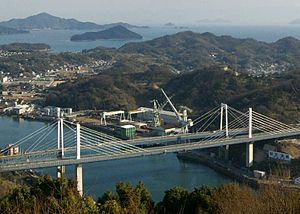Onomichi Bridge
Coordinates: 34 ° 24 ′ 34 ″ N , 133 ° 13 ′ 0 ″ E
| Onomichi Bridge ( 尾 道 大橋 ) | ||
|---|---|---|
|
Onomichi Bridge (back) and the newer Shin Onomichi Bridge |
||
| use | Road bridge | |
| Convicted | National road 317 | |
| Crossing of | Onomichi Channel, Seto Inland Sea | |
| place | Onomichi | |
| construction | Cable-stayed bridge | |
| overall length | 385 m | |
| width | 10.4 m | |
| Number of openings | three | |
| Longest span | 215 m | |
| Clear height | 36 m | |
| start of building | 1966 | |
| completion | 1968 | |
| planner | Japan Bridge & Structure Institute | |
| location | ||
|
|
||
The Onomichi Bridge ( Japanese 尾 道 大橋 , Onomichi-ōhashi ) is a road bridge in Onomichi in Hiroshima Prefecture in Japan , which leads the national road 317 over the Onomichi Canal, a branch of the Seto Inland Sea , and thus the central area of the place connects with the island of Mukaijima, which also belongs to him.
The Onomichi Bridge is the oldest of the Japanese cable-stayed bridges with a span of more than 200 m .
About 30 m west of it is the newer Shin-Onomichi Bridge , which leads the Nishiseto highway over the inlet.
description
The Onomichi Bridge, with its two lanes, only serves local traffic after the construction of the motorway bridge. It has two walkways separated from the lanes by barriers, but they are only 1.20 m wide and are occupied by the anchorages of the stay cables. Cyclists are therefore advised to take the ferry.
The cable-stayed bridge , which was built between 1966 and 1968, has two frame-shaped pylons that stand on heavy concrete pillars arranged below the girder. The pylons reach a height of 72.4 m above sea level. Two stay cables are anchored in the tuft system at each of the pylon heads - in the simplest system from a static point of view, which could still be calculated without the powerful computers that were necessary for the later cable-stayed bridges with numerous cables.
The main opening between the pylons has a span of 215 m, the two side openings of 85 m each. The bridge has a clearance height of 36.46 m.
The total of 10.40 m wide and 3.20 m high steel deck girder is slightly curved upwards in the longitudinal axis. As a result of wind tunnel tests, it has a central reservation made of an open grating integrated into the roadway. It consists of an orthotropic plate on two solid wall girders and diagonal struts under each lane. A 6.5 cm thick layer of asphalt forms the road surface.
It was originally subject to toll , but the toll period ended in 2013.
Web links
Individual evidence
- ↑ Masao Naruoka, Takashi Sakamoto: Rope- tensioned girder bridges in Japan . In: acier - stahl - steel , issue 10/1973, p. 413

